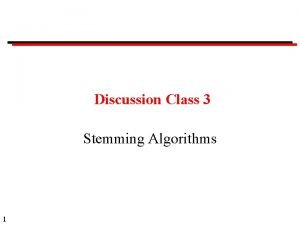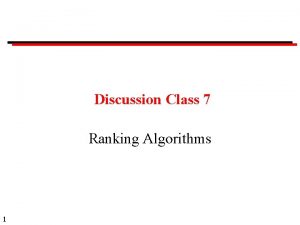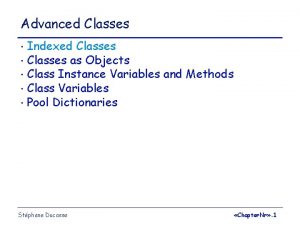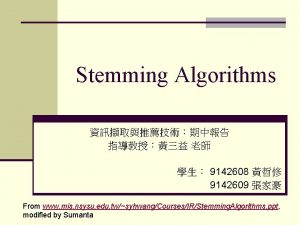Discussion Class 5 Stemming Algorithms 1 Discussion Classes










- Slides: 10

Discussion Class 5 Stemming Algorithms 1

Discussion Classes Format: Question Ask a member of the class to answer Provide opportunity for others to comment When answering: Give your name. Make sure that the TA hears it. Stand up Speak clearly so that all the class can hear 2

Question 1: Conflation methods (a) Define the terms: stem, suffix, prefix, conflation, morpheme (b) Define the terms in the following diagram: Conflation methods Manual Automatic (stemmers) Affix removal Longest match 3 Successor variety Simple removal Table lookup n-gram

Question 2: Table look-up (a) What are the advantages and disadvantages of table look-up methods? (b) When would you use table look-up? 4

Question 3: Successor variety methods Hafer and Weiss defined their technique as: Let be a word of length n, i is a length i prefix of . Let D be the corpus of words. D i is defined as the subset of D containing the terms whose first i letters match i exactly. The successor variety of i, denoted by S i, is then defined as the number of letters that occupy the i+1 st position of words in D i. A test word of length n has n successor varieties S i, . . . , S i. Explain this definition, using the word "computation" as an example. 5

Question 4: Successor variety methods With successor variety methods, how do the following methods of segmentation work? (a) cutoff method (b) peak and plateau method (c) complete word method 6

Question 5: n-gram methods (a) Explain the following notation: statistics => st ta at ti is st ti ic cs unique diagrams =>at cs ic is st ta ti statistical => st ta at ti is st ti ic ca al unique diagrams => al at ca ic is st ta ti (b) Calculate the similarity using Dice's coefficient: 2 C S= A+B A is the number of unique diagrams in the first term B is the number of unique diagrams in the second term C is the number of shared unique diagrams 7 (c) How would you use this approach for stemming?

Question 6: Porter's algorithm (a) What is an iterative, longest match stemmer? (b) How is longest match achieved in the Porter algorithm? 8

Question 7: Porter's algorithm Conditions Suffix Replacement Examples (m > 0) eed ee feed -> feed agreed -> agree (*v*) ed null plastered -> plaster bled -> bled (*v*) ing null motoring -> motor sing -> sing (a) Explain this table (b) How does this table apply to: "exceeding", "ringed"? 9

Question 8: Evaluation (a) What is the overall effectiveness of stemming? (b) Give a possible reason why Stemmer A might be better than Stemmer B on Collection X but worse on Collection Y. 10
 Stemming algorithms
Stemming algorithms Benefits stemming from space exploration
Benefits stemming from space exploration Classe e subclasse de que
Classe e subclasse de que Pre ap classes vs regular classes
Pre ap classes vs regular classes Conclusion of distillation
Conclusion of distillation Class discussion rules
Class discussion rules Are you going to class today
Are you going to class today Package mypackage; class first { /* class body */ }
Package mypackage; class first { /* class body */ } Difference between abstract class and concrete class
Difference between abstract class and concrete class What is the lower boundary of the modal class
What is the lower boundary of the modal class Class i vs class ii mhc
Class i vs class ii mhc


















